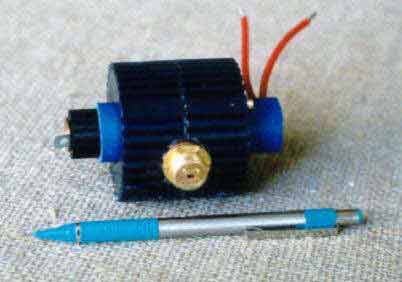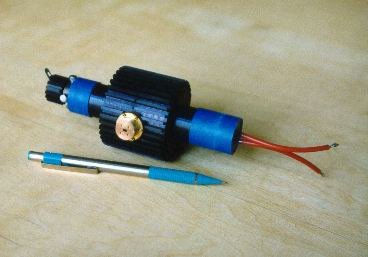Products
Conventional magnetrons do not operate effectively at frequencies of 95 GHz and higher due to the following limitations: (i) the dimensions of magnetron cavity become too small since they scale as l, the wavelength; (ii) the necessary current density and back-bombarding are so intense that the lifetime of thermionic cathodes is too short for practical applications.
To overcome the limitations mentioned, the spatial-harmonic magnetron (SHM) with secondary-emission cathode has been proposed as an alternative to conventional magnetrons. The distinctive features of such magnetrons are as following: (i) they utilise a backward-wave spatial harmonic of the p/2 resonator mode for the magnetron operation, distinct from the conventional p-mode, and (ii) a cold secondary emission cathode is introduced instead of the conventional thermionic cathode.
As for the cold secondary-emission cathode, it was found that a platinum foil placed on copper core serves as an effective cathode providing a high level of the secondary emission under electron bombarding. An auxiliary thermal cathode placed outside the interaction space initiates the secondary emission.
These solutions resulted in a number of advances, like: the dimensions of the oscillatory system is increased, the frequency separation between neighbouring modes is improved, the needed values of the dc magnetic field is much smaller, a higher stability of magnetron operation is achieved, and the life time of the magnetrons is essentially extended.
It should be noted that the proposed magnetrons operate with the magnetic field values, which are smaller, for example, by factor around 3 for 3 mm-wave magnetrons, what resulted in an essential decrease of the magnetron dimensions and the weight as well.
The above mentioned approaches resulted in the appearance of magnetrons capable for efficient operation throughout the whole millimeter wave band. Characteristics of the magnetrons developed and produced at the Department are summarised in Table 1. Low voltage 95 GHz magnetrons, which operate with the anode voltage of 9 kV and lower are available. The weight of these magnetrons is only several hundred grams. Photos of a 1 kW, 95 GHz miniature magnetron and a 4 kW, 95 GHz magnetron are shown in Fig. 1 and 2, respectively.
| Operating frequency, GHz | Peak output power, kW | Average output power, W | Pulse duration, ms | Peak anode voltage, kV | Weight, kg |
| 36 | 75 | 80 | 0.2 | 19 | 2.0 |
| 44 | 120 | 30 | 0.1 | 26 | 2.7 |
| 44 | 40 | 50 | 0.2 | 19 | 2.2 |
| 44 | 40 | 20 | 0.2 | 19 | 2.5 |
| 73 | 35 | 20 | 0.1 | 18 | 2.0 |
| 95 | 20 | 20 | 0.1 | 18 | 2.0 |
| 95 | 13 | 20 | 0.2 | 16.5 | 1.8 |
| 95 | 7 | 10 | 0.3 | 15 | 1.5 |
| 95 | 1 | 1 | 0.3 | 6.5 | 0.5 |
| 95 | 2 | 2 | 0.2 | 8.5 | 0.5 |
| 95 | 4 | 4 | 0.2 | 10 | 0.7 |
| 136 | 7 | 7 | 0.07 | 15 | 1.7 |
| 136 | 3 | 3 | 0.1 | 13 | 1.5 |
 Fig. 1. Photograph of 1 kW, 95 GHz magnetron.
Fig. 1. Photograph of 1 kW, 95 GHz magnetron.  Fig. 2. Photograph of 4 kW, 95 GHz magnetron.
Fig. 2. Photograph of 4 kW, 95 GHz magnetron.
